Spatial-Temporal Characteristics of Agricultural Greenhouse Gases Emissions of the Main Stream Area of the Yellow River Basin in Gansu, China
Abstract
:1. Introduction
2. The Study Area and the Data Resources
3. Materials and Methods
3.1. Emission Quantity and Intensity Measurement Method
3.2. Standard Deviation and Coefficient of Variation
3.3. Spatial Variability Analysis
4. Result
4.1. Analysis of Total Agricultural GHG Emissions
4.1.1. The Analysis of Time Series
- (1)
- During the period of fast-growth (2000–2008), agricultural GHG emissions increased from 62.577 kt to 105.795 kt, and GHG emissions reached the highest value in the study phase.
- (2)
- During the period of slow-decline (2009–2014), a downward trend appeared, and overall, GHG emissions fell 1.55% from 103.5624 kt to 103.4023 kt.
- (3)
- During the period of fast-decline (2015–2019), agricultural GHG emissions decreased by 3.76% from 101.1393 kt to 97.3355 kt, with an average annual decline of 1.88%.
- (1)
- During the period of slow-descent stage (2000–2004), agricultural GHG emissions intensity from 0.016 to 0.011, down by 31.25% in this period, with an average annual decline of 9%. It shows that the agricultural production efficiency shows a higher growth trend.
- (2)
- During the period of slow-growth slow decline (2005–2008), agricultural GHG emissions intensity from 0.011 to 0.013, down for 18.02 percent in this period, with an average annual increase of 5.72%. Agricultural production efficiency declined in this stage.
- (3)
- During the period of fast-decline (2009–2019), agricultural GHG emissions intensity from 0.011 to 0.004, down by 63.64% in this period, with an average annual decline of 9.62%.
4.1.2. Different Types of Agricultural GHG Analysis
- (1)
- Agricultural emissions of CO2 are the largest in agricultural GHG, increasing from 177.57 kt in 2000 to 270.83 kt in 2019, an increase of 52.52 percent, an average annual increase of 2.25%, the trend shows a smaller increase.
- (2)
- Emissions of CO2/CH4 in paddy fields (agricultural cultivation) are the smallest in agricultural GHG, from 0.86 kt in 2000 to 0.40 kt in 2019, a drop of 53.49 percent, and an average annual decline of 3.95%, so the trend shows a smaller decline. The emission of N2O in agricultural cultivation is also relatively smaller among agricultural greenhouse gases, increasing from 3.64 kt in 2000 to 6.66 kt in 2019, increase for 82.97%, an average annual increase of 5.28%, so the trend shows a smaller increase.
- (3)
- Emissions of CO2/CH4 in livestock: the emissions of CH4 and N2O maintain a basically consistent change trend, but the average annual growth rate of the emissions of CH4 is higher than that of N2O. The emissions of CH4 increased from 43.49 kt in 2000 to 68.82 kt in 2019, increase for 58.24 percent, an average annual increase of 5.28%, the trend shows a smaller increase. The emissions of N2O increased from 12.97 kt in 2000 to 19.14 kt in 2019, increase for 47.57 percent, an average annual increase of 2.07%, the trend shows a smaller increase.
4.1.3. Spatial Sequence Analysis
4.2. The Spatial Characteristics of Carbon Emissions in Counties and Districts
4.2.1. Analysis of Total GHG Emissions
4.2.2. Analysis of GHG Emissions Intensity
4.2.3. Spatial Difference Analysis of Total GHG Emissions and GHG Emissions Intensity
- (1)
- From 2000 to 2005, this stage was the first decline phase. The standard deviation was 633.24 in 2004, reaching the lowest level in the study period. The coefficient of variation was 1.41 in 2005, at the lowest level in 2000–2019, both relative and absolute gap in the process of narrowing.
- (2)
- From 2006 to 2008, as a period of rapid growth, both peaked in 2008 and increased by 70.09% and 24.35%, respectively, with a relative gap exceeding the absolute gap.
- (3)
- From 2009 to 2013 was the second decline phase, with the standard deviation and coefficient of variation falling 16.68% and 13.81%, respectively, both above the mean of the study period, indicating a further expansion of the relative and absolute gap between counties.
- (4)
- From 2014 to 2017 was a stable transition period, and the standard deviation and coefficient of variation remained basically unchanged, indicating that the relative and absolute gap between counties remained basically stable.
- (5)
- From 2018 to 2019 was a rapid decline period, with the standard deviation and coefficient of variation decreasing 7.40% and 7.14%, respectively, indicating a gradual narrowing of the relative and absolute gap between counties.
5. Discussion
6. Conclusions
Author Contributions
Funding
Institutional Review Board Statement
Informed Consent Statement
Data Availability Statement
Conflicts of Interest
References
- Food and Agriculture Organization (FAO). Food security and agricultural mitigation in developing countries: Options for capturing synergies; Rome FAO: Roma, Italy, 2009. [Google Scholar]
- Zhang, J.X.; Hu, W.L.; Wang, H.L. Analysis of the timing characteristics and influencing factors of agricultural carbon emission in Hubei Province. Hubei Agric. Sci. 2020, 59, 67–74. [Google Scholar]
- Qin, Z.C.; Deng, S.Y.; Dunn, J.; Smith, P.; Sun, W.J. Animal waste use and implications to agricultural greenhouse gas emissions in the United States. Environ. Res. Lett. 2021, 16. [Google Scholar] [CrossRef]
- Deng, C.X.; Li, R.R.; Xie, B.G.; Wan, Y.L.; Li, Z.W.; Liu, C.C. Impacts of the integrated pattern of water and land resources use on agricultural greenhouse gas emissions in China during 2006–2017: A water-land-energy-emissions nexus analysis. J. Clean. Prod. 2021, 308. [Google Scholar] [CrossRef]
- Isbasoiu, A.; Jayet, P.A.; Stéphane, D.C. Increasing food production and mitigating agricultural greenhouse gas emissions in the European Union: Impacts of carbon pricing and calorie production targeting. Environ. Econ. Policy Stud. 2020, 23, 409–440. [Google Scholar] [CrossRef]
- Vanesa, Z.M.; Marc, P.; María, S.A. GARCH model to estimate the impact of agricultural greenhouse gas emissions per sociodemographic factors and CAP in Spain. Environ. Dev. Sustain. 2020, 23, 4675–4697. [Google Scholar]
- Jantke, K.; Hartmann, M.J.; Rasche, L.; Blanz, B.; Schneider, U.A. Agricultural Greenhouse Gas Emissions: Knowledge and Positions of German Farmers. Land 2020, 9, 130. [Google Scholar] [CrossRef]
- Kumar, A.; Sharma, M.P. Estimation of green house gas emissions from Koteshwar hydropower reservoir, India. Environ. Monit. Assess. 2017, 189, 189–240. [Google Scholar] [CrossRef]
- Jin, J.K. Documenthiometric analysis of Agricultural greenhouse gas emission research in China. Anhui Agric. Not. 2019, 25, 116–118+136. [Google Scholar]
- He, Y.Q.; Cheng, X.Y.; Wang, F.; Cheng, Y. Spatial correlation of China’s agricultural greenhouse gas emissions: A technology spillover perspective. Nat. Hazards 2020, 104, 2561–2590. [Google Scholar] [CrossRef]
- Zhang, J.M.; Zhang, B. Accounting method of agricultural greenhouse gas emission in Heilongjiang Province. Stat. Consult. 2017, 2, 14–16. [Google Scholar]
- Jin, S.T.; Han, D.M.; Lin, Y.; Hu, J.Z. Prospect analysis and policy suggestions for agricultural carbon trading under the carbon peak target. Rural Financ. Res. 2021, 6, 3–8. [Google Scholar]
- Deng, X.Z.; Dan, L.; Ye, Q.; Wang, Z.H.; Liu, Y.; Zhang, X.Y.; Zhang, F.; Qi, W.; Wang, G.F.; Wang, P.; et al. Progress and methods of socio-economic cost of carbon emission and carbon reduction. J. Earth Inf. Sci. 2018, 20, 405–413. [Google Scholar]
- Li, Y.; Chen, M.P. Spatiotemporal characteristics of agricultural source non-carbon dioxide greenhouse gas emissions in the Yangtze River Economic Belt. Chin. Environ. Sci. 2020, 40, 2030–2039. [Google Scholar]
- Zhang, S.X. Analysis of agricultural carbon emissions measurement and influencing factors in China-Research based on provincial panel data. Hubei Agric. Sci. 2021, 60, 60–64+95. [Google Scholar]
- Zhu, S.M.; Wu, Q.; Mao, Y.L.; Zhang, L.M.; Long, J. Research on Agricultural Methane Emission Estimation in Fujian Province in 1980–2011. J. Henan Agric. Univ. 2017, 51, 250–257. [Google Scholar]
- Xie, L.Y.; Yang, S.Y.; Zhang, C.L.; Yang, W. Characteristics of Agricultural Source Greenhouse Gas emission in Anhui Province. China Agric. Sci. Bull. 2020, 36, 88–91. [Google Scholar]
- Zhao, P.F.; Tan, Y.; Yang, Y. Empirical study on the influencing factors of carbon emission trading price-Take the greenhouse gas emission quota in Hubei Province as an example. J. Wuhan Shipbuild. Vocat. Tech. Coll. 2020, 19, 118–123. [Google Scholar]
- Wang, L. Research on planting industry carbon emission in Hubei Province; Wuhan University Light Industry: Wuhan, China, 2019. [Google Scholar]
- Chu, T.S.; Lai, S.X.; Yang, Z.L. Accounting of greenhouse gas emission and soil carbon fixation in Heilongjiang Agricultural Reclamation Production System. J. China Agric. Univ. 2021, 26, 143–156. [Google Scholar]
- Luo, T.T. Study on comprehensive evaluation of wheat-maize in different ecological zones in Henan; Henan Normal University: Kaifeng, China, 2020. [Google Scholar]
- Fan, X.K.; Zheng, A.Q. Estimation of greenhouse gas emission reduction potential of "breeding-biogas" ecological model in Shaanxi Province. Shaanxi Agric. Sci. 2019, 65, 36–42. [Google Scholar]
- Sun, F. Study on Market Mechanism of Agricultural Greenhouse Gas Reduction in China; Chinese Academy of Agricultural Sciences: Beijing, China, 2012. [Google Scholar]
- Chen, H.; Fu, G.H.; Liu, Y.Z. Agricultural greenhouse gas emissions in Jiangsu Province: Spatial and temporal differences and trend evolution. Resour. Sci. 2018, 40, 1084–1094. [Google Scholar]
- Kang, T.; Yang, H.Z.; Guo, R. Agricultural greenhouse gas emission accounting in Chongming. Resour. Environ. Yangtze Basin 2012, 21, 102–108. [Google Scholar]
- Zhang, X.Z.; Wang, J.Y.; Zhang, T.L.; Li, B.L.; Yan, L. Assessment of methane emissions and low carbon measures in China. Environ. Sci. Technol. 2021, 44, 200–208. [Google Scholar]
- Shang, J.; Yang, G.; Yu, F.W. Agricultural greenhouse gases emissions and influencing factors in China. Chin. J. Eco-Agric. 2015, 23, 354–364. [Google Scholar]
- Li, R. Estimate and characteristics of agricultural greenhouse gas emissions in Anhui Province. J. Henan Agric. Sci. 2014, 43, 77–82. [Google Scholar]
- West, T.O.; Marland, G. A synthesis of carbon sequestration, carbon emissions, and net carbon flux in agriculture: Comparing tillage practices in the United States. Agric. Ecosyst. Environ. 2002, 91, 217–232. [Google Scholar] [CrossRef]
- Kumar, A.; Yang, T.; Sharma, M.P. Greenhouse gas measurement from Chinese freshwater bodies:A review. J. Clean. Prod. 2019, 233, 56–62. [Google Scholar] [CrossRef]
- Zhou, R.J.; Yan, Z.G. Based on the comparison and analysis of agricultural carbon emissions and carbon absorption in Gansu Province for nearly 10 years. Product. Res. 2020, 7, 61–64. [Google Scholar]
- Liao, W.D.; Liu, M. Spatiotemporal evolution of agricultural carbon emissions in western regions and the EKC hypothesis test-Empirical analysis of dynamic panel data model in 12 provinces in western China. World Agric. 2020, 6, 62–70. [Google Scholar]
- Wang, L.X.; Hong, M.Y. Empirical Analysis of the Relationship between Agricultural Production Performance and Carbon emission Strength in China. J. Shihezi Univ. (Philos. Soc. Sci. Ed.) 2018, 32, 56–62. [Google Scholar]
- Tian, P.P.; Lu, H.W.; Li, D.; Yin, C.; Xia, J. Spatial-temporal evolution pattern of carbon footprint of fertilizer application in China in 2008–2017. Chin. Environ. Sci. 2021, 41, 967–973. [Google Scholar]
- Tang, Y.F.; Li, H.X.; Liu, J.H.; Wang, J.L.; Ma, L.R. Study on Grain Production Situation and Grain Security Countermeasures in Gansu Province. Gansu Agric. Sci. Technol. 2021, 52, 63–71. [Google Scholar]
- Chen, B.P.; Liu, Y.; He, L.L. Research on agricultural land use efficiency based on the DEA and Malmquist Index-Take Gansu as an example. Sci. Technol. Econ. 2021, 34, 51–55. [Google Scholar]
- Cao, L.; Wang, Y.; Lei, S.J. Study on spatial and temporal characteristics and decoupling elasticity of Agricultural carbon emission in Shandong Province. Jiangsu Agric. Sci. 2020, 48, 250–256. [Google Scholar]
- Li, B.; Du, J.G.; Liu, X.Q. Space and temporal characteristics and economic correlation of agricultural carbon emissions in Hubei Province. Chin. Agric. Sci. 2019, 52, 4309–4319. [Google Scholar]
- Li, G.Z.; Li, Z.Z. Empirical analysis of carbon emission factor decomposition of agricultural energy consumption in China. Agric. Tech. Econ. 2010, 10, 66–72. [Google Scholar]
- Ma, L.J.; Zhong, N.N.; Zou, Z.R.; Li, Y.H.; Yao, N.; Gao, W.; Liu, B.S. Current situation of energy conservation and emission reduction in China. Agric. Eng. 2016, 6, 12–13. [Google Scholar]

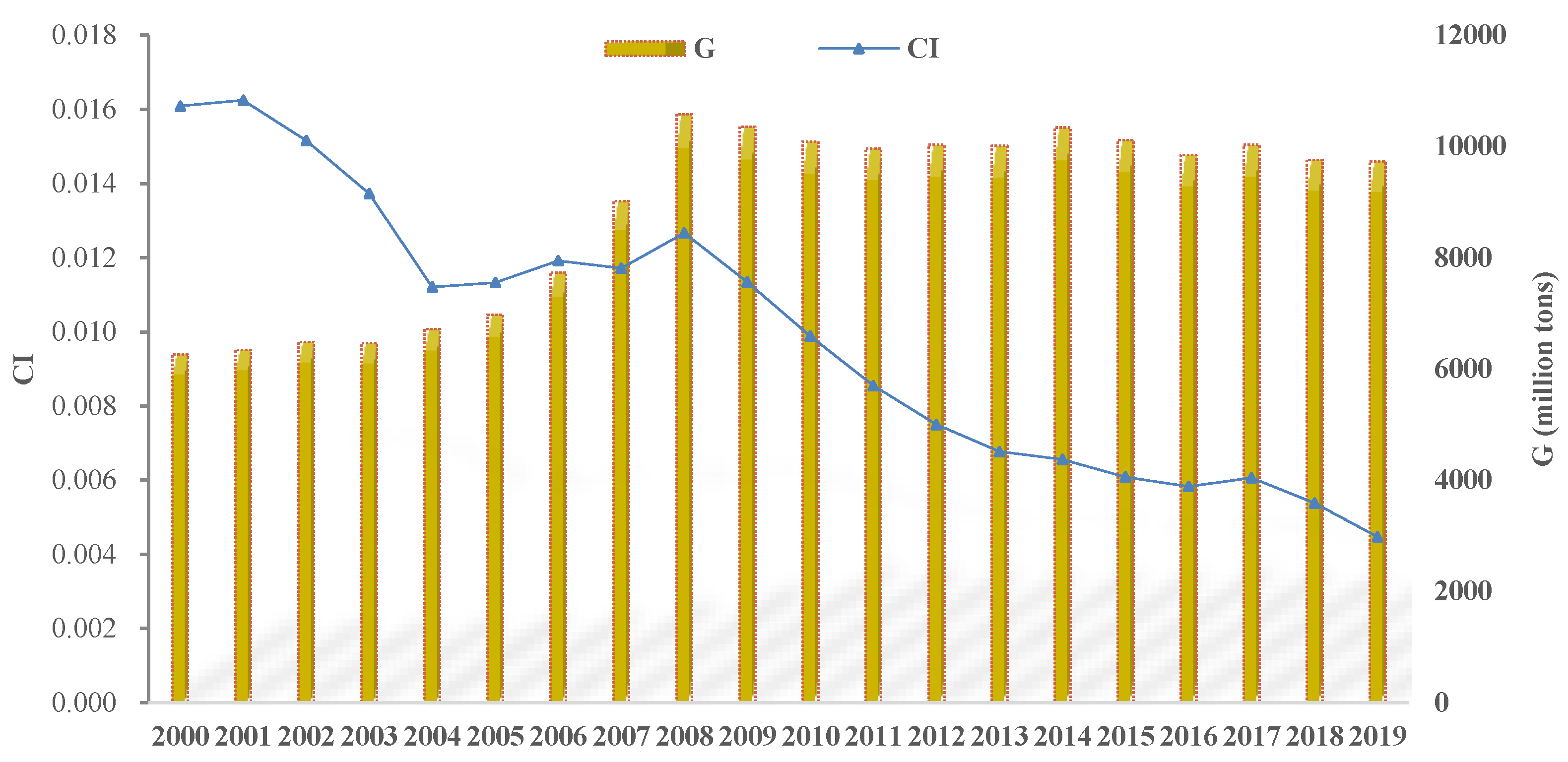
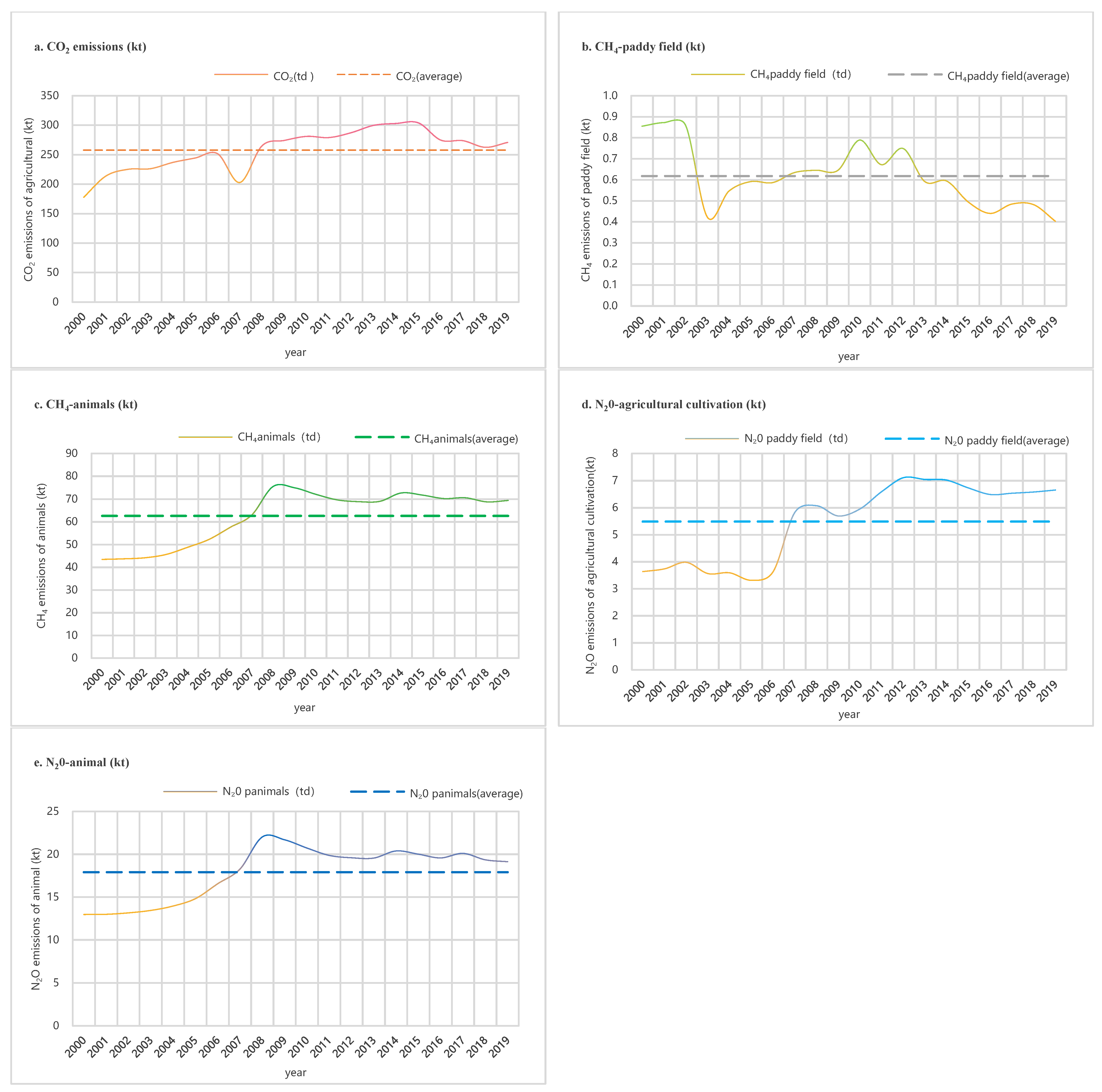
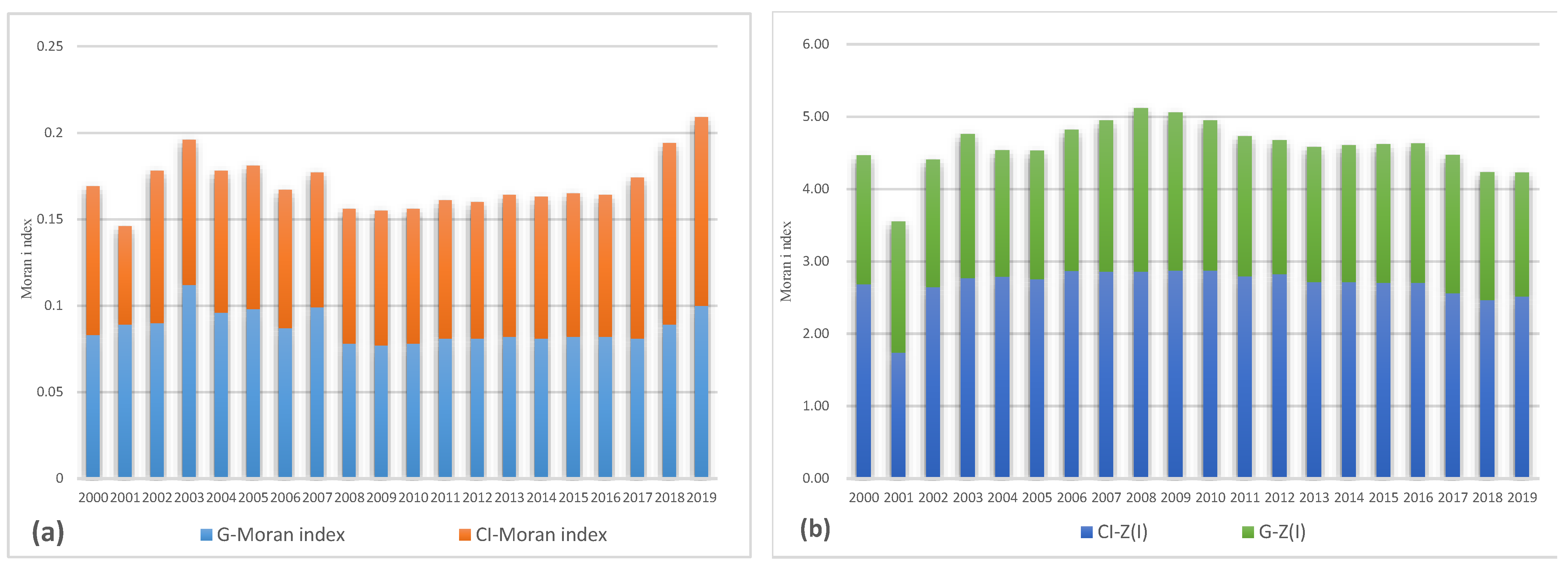
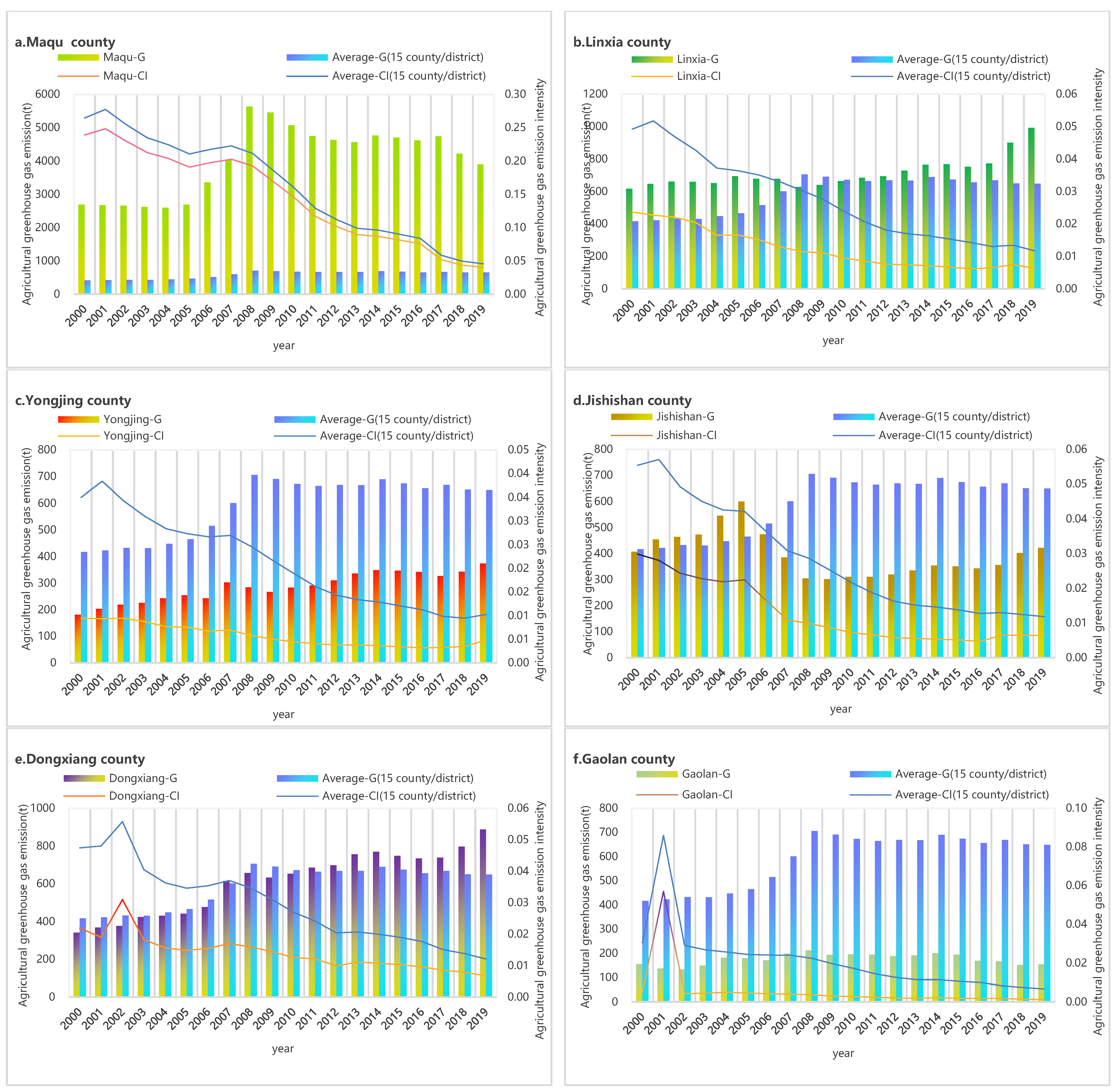
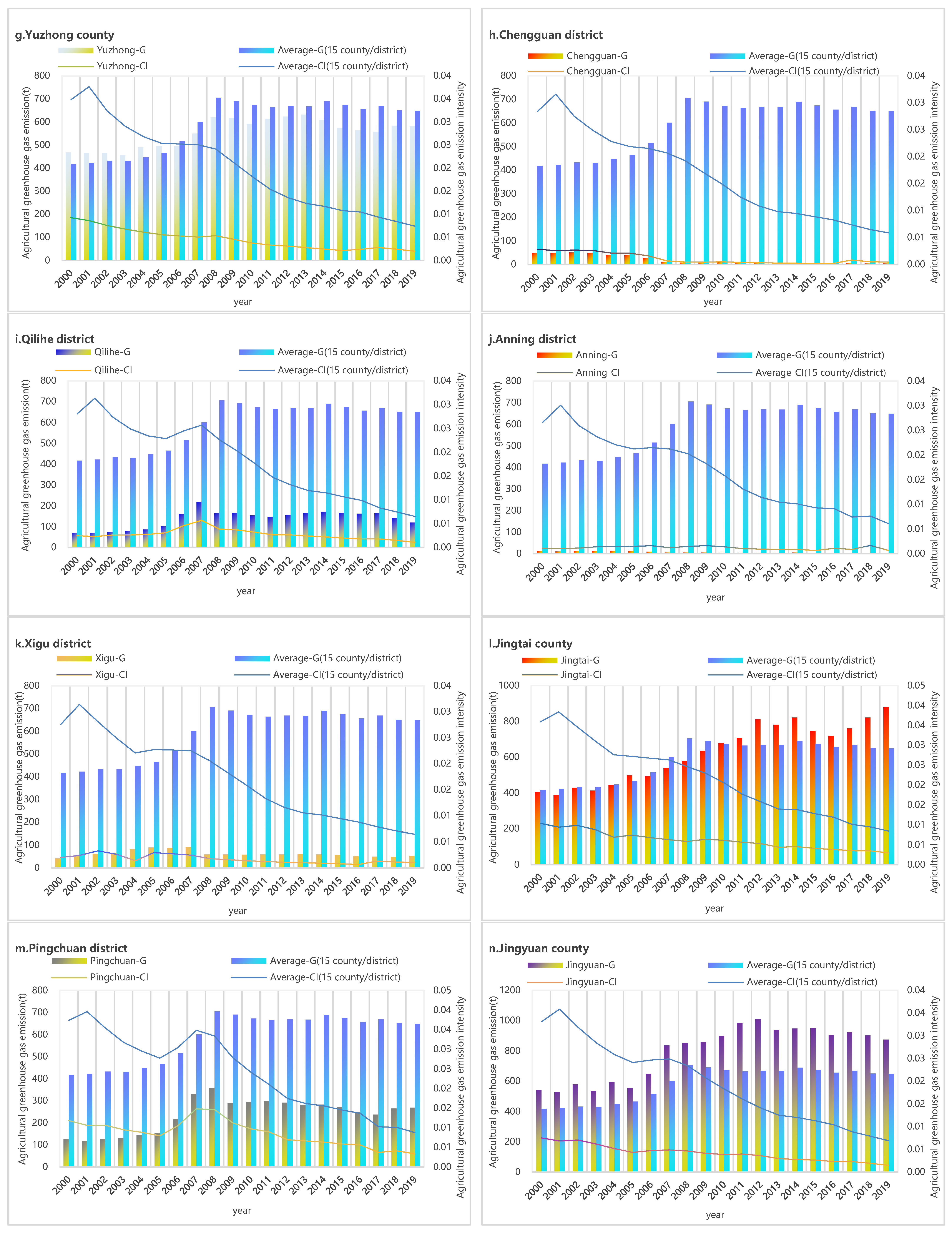
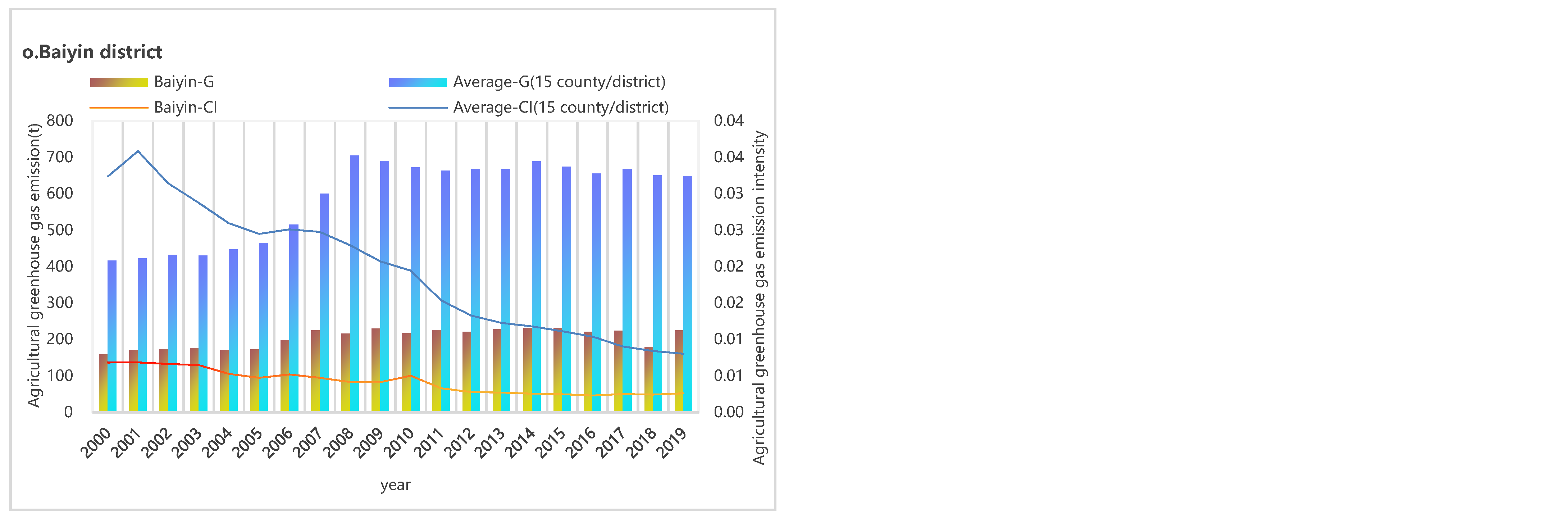
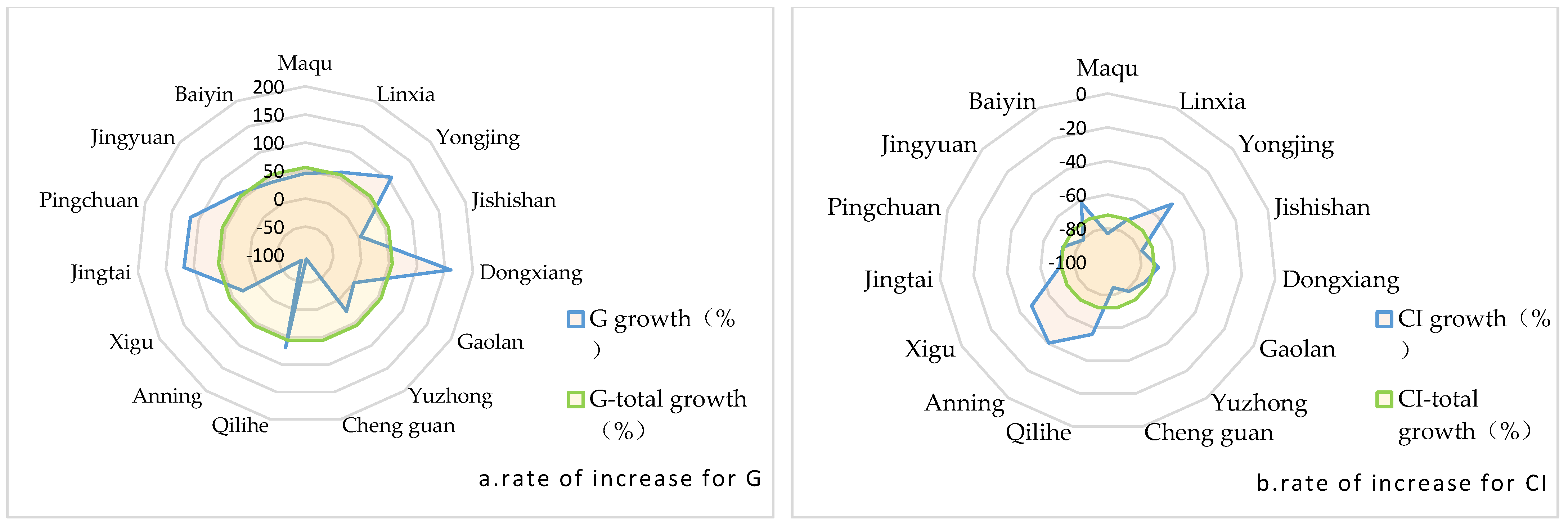

| Case Cities | Case Counties (Districts) | Main Agricultural Products a | Population (104) | Area (km2) | GDP b (104 U.S. dollar) |
|---|---|---|---|---|---|
| Gannan Tibetan Autonomous Prefecture | Maqu | Cattles (455.5 th) Sheep (367.4 th) | 5.9 | 9637 | 36,925.99 |
| Linxia Hui Autonomous Prefecture | Linxia | Corn (79.524 kt) Wheat (30.8 kt) Tubers (20.301 kt) | 29.56 | 1212.4 | 140,083.51 |
| Yongjing | Corn (62.300 kt) Tubers (15.200 kt) Wheat (5.800 kt) | 18.79 | 1864 | 79,492.51 | |
| Jishishan | Corn (41.90 kt) Tubers (8.80 kt) Wheat (7.28 kt) | 24.76 | 910 | 37,087.40 | |
| Dongxiang | Corn (68.02 kt) Tubers (50.89 kt) Wheat (3.35 kt) | 30.81 | 1268 | 50,663.45 | |
| Lanzhou city | Gaolan | Corn (9.65 kt) Tubers (7.15 kt) Wheat (4.33 kt) | 11.06 | 2180 | 117,369.12 |
| Yuzhong | Corn (69.03 kt) Tubers (27.04 kt) Wheat (15.77 kt) | 44.7 | 3302 | 241,192.62 | |
| Chengguan | Vegetables (5.94 kt) | 133.07 | 207.84 | 160,319.02 | |
| Qilihe | Corn (3.04 kt) Vegetables (227.69 kt) | 58.34 | 394.47 | 781,753.66 | |
| Anning | Vegetables (0.94 kt) | 28.76 | 82.33 | 348,620.26 | |
| Xigu | Vegetables (122.36 kt) | 37.27 | 358.32 | 637,621.69 | |
| Baiyin city | Baiyin | Corn (18.66 kt) Wheat (2.30 kt) | 30.47 | 1352 | 338,740.59 |
| Pingchuan | Corn (24.63 kt) Tubers (10.17 kt) Wheat (6.93 kt) | 19.8 | 2106 | 108,263.95 | |
| Jingtai | Corn (134.83 kt) Legumes (26.06 kt) Wheat (39.85 kt) Paddy (3.25 kt) | 22.56 | 5483 | 86,540.62 | |
| Jingyuan | Sheep (409.30 kh) Paddy (9.82 kt) Tubers (43.27 kt) Legumes (10.30 kt) Corn (112.51 kt) Wheat (27.90 kt) | 46.68 | 5792 | 108,751.11 |
| Year | 2000 | 2001 | 2002 | 2003 | 2004 | 2005 | 2006 | 2007 | 2008 | 2009 | |
| C(D) | |||||||||||
| Maqu | 26.8842 | 26.7297 | 26.6174 | 26.2132 | 26.0072 | 26.8803 | 33.5763 | 40.2722 | 56.3164 | 54.5594 | |
| Linxia | 6.1740 | 6.4731 | 6.6079 | 6.5884 | 6.5105 | 6.9433 | 6.7819 | 6.7829 | 6.2738 | 6.4073 | |
| Yongjing | 1.8118 | 2.0294 | 2.1923 | 2.2599 | 2.4325 | 2.5401 | 2.4318 | 3.0236 | 2.8470 | 2.6731 | |
| Jishishan | 4.0714 | 4.5457 | 4.6409 | 4.7304 | 5.4611 | 6.0046 | 4.7462 | 3.8569 | 3.0514 | 3.0157 | |
| Dongxiang | 3.4106 | 3.6872 | 3.7669 | 4.2415 | 4.3109 | 4.4103 | 4.7597 | 6.1513 | 6.5695 | 6.3237 | |
| Gaolan | 1.5467 | 1.3688 | 1.3308 | 1.4847 | 1.8143 | 1.7936 | 1.7092 | 1.9866 | 2.1264 | 1.9280 | |
| Yuzhong | 4.6828 | 4.6516 | 4.6484 | 4.5622 | 4.9089 | 4.9501 | 4.9641 | 5.5015 | 6.1930 | 6.1748 | |
| Chengguan | 0.4944 | 0.4807 | 0.5084 | 0.4893 | 0.3993 | 0.4014 | 0.2656 | 0.1192 | 0.0822 | 0.0803 | |
| Qilihe | 0.7055 | 0.7063 | 0.7410 | 0.7789 | 0.8573 | 1.0229 | 1.5929 | 2.1866 | 1.6465 | 1.6698 | |
| Anning | 0.1110 | 0.1055 | 0.1099 | 0.1118 | 0.1312 | 0.1272 | 0.0886 | 0.0519 | 0.0536 | 0.0513 | |
| Xigu | 0.4124 | 0.5528 | 0.6132 | 0.6687 | 0.8066 | 0.8976 | 0.8750 | 0.9039 | 0.5880 | 0.5850 | |
| Jingtai | 4.0421 | 3.8818 | 4.2915 | 4.1275 | 4.4317 | 4.9779 | 4.9227 | 5.3908 | 5.7879 | 6.3526 | |
| Pingchuan | 1.2474 | 1.1789 | 1.2618 | 1.2915 | 1.4206 | 1.5391 | 2.1583 | 3.2995 | 3.5689 | 2.8796 | |
| Jingyuan | 5.3965 | 5.2752 | 5.7823 | 5.3517 | 5.9423 | 5.5486 | 6.4863 | 8.3453 | 8.5269 | 8.5646 | |
| Baiyin | 1.5864 | 1.7061 | 1.7432 | 1.7720 | 1.7078 | 1.7299 | 1.9841 | 2.2556 | 2.1633 | 2.2971 | |
| Average | 4.1718 | 4.2249 | 4.3237 | 4.3114 | 4.4761 | 4.6511 | 5.1562 | 6.0085 | 7.0530 | 6.9042 | |
| Year | 2010 | 2011 | 2012 | 2013 | 2014 | 2015 | 2016 | 2017 | 2018 | 2019 | |
| C(D) | |||||||||||
| Maqu | 50.7376 | 47.4740 | 46.3476 | 45.6430 | 47.6939 | 47.0254 | 46.1960 | 47.4052 | 42.1954 | 38.9603 | |
| Linxia | 6.6484 | 6.8481 | 6.9383 | 7.2922 | 7.6454 | 7.6761 | 7.5307 | 7.7367 | 9.0041 | 9.9183 | |
| Yongjing | 2.8317 | 2.9063 | 3.0990 | 3.3618 | 3.4860 | 3.4634 | 3.4177 | 3.2683 | 3.4327 | 3.7405 | |
| Jishishan | 3.1119 | 3.1071 | 3.1976 | 3.3528 | 3.5378 | 3.5102 | 3.4305 | 3.5593 | 4.0262 | 4.2235 | |
| Dongxiang | 6.5270 | 6.8584 | 6.9792 | 7.5617 | 7.6930 | 7.4759 | 7.3464 | 7.3870 | 7.9667 | 8.8771 | |
| Gaolan | 1.9505 | 1.9406 | 1.8758 | 1.9089 | 2.0052 | 1.9439 | 1.6875 | 1.6688 | 1.5217 | 1.5434 | |
| Yuzhong | 5.9190 | 6.1395 | 6.2344 | 6.3165 | 6.0956 | 5.7438 | 5.6341 | 5.5756 | 5.8335 | 5.8299 | |
| Chengguan | 0.0960 | 0.0884 | 0.0870 | 0.0771 | 0.0734 | 0.0715 | 0.0692 | 0.0678 | 0.0433 | 0.0390 | |
| Qilihe | 1.5355 | 1.4807 | 1.5742 | 1.6518 | 1.7220 | 1.6678 | 1.6275 | 1.6461 | 1.4070 | 1.1951 | |
| Anning | 0.0470 | 0.0442 | 0.0441 | 0.0468 | 0.0482 | 0.0367 | 0.0347 | 0.0332 | 0.0228 | 0.0141 | |
| Xigu | 0.5817 | 0.5912 | 0.5903 | 0.6019 | 0.5836 | 0.5568 | 0.5010 | 0.4960 | 0.4870 | 0.5295 | |
| Jingtai | 6.7822 | 7.0743 | 8.1026 | 7.8114 | 8.2133 | 7.4570 | 7.1892 | 7.6043 | 8.2111 | 8.7928 | |
| Pingchuan | 2.9398 | 2.9740 | 2.9160 | 2.8113 | 2.8205 | 2.6951 | 2.4998 | 2.3650 | 2.6448 | 2.6818 | |
| Jingyuan | 8.9923 | 9.8452 | 10.0868 | 9.3827 | 9.4671 | 9.4945 | 9.0419 | 9.2280 | 9.0088 | 8.7408 | |
| Baiyin | 2.1694 | 2.2591 | 2.2090 | 2.2811 | 2.3173 | 2.3211 | 2.2148 | 2.2392 | 1.7978 | 2.2493 | |
| Average | 50.7376 | 47.4740 | 46.3476 | 45.6430 | 47.6939 | 47.0254 | 46.1960 | 47.4052 | 42.1954 | 38.9603 | |
| Year | 2000 | 2001 | 2002 | 2003 | 2004 | 2005 | 2006 | 2007 | 2008 | 2009 | |
| C(D) | |||||||||||
| Maqu | 0.2391 | 0.2485 | 0.2297 | 0.2125 | 0.2038 | 0.1908 | 0.1976 | 0.2027 | 0.1928 | 0.1690 | |
| Linxia | 0.0237 | 0.0227 | 0.0221 | 0.0204 | 0.0165 | 0.0166 | 0.0151 | 0.0129 | 0.0115 | 0.0111 | |
| Yongjing | 0.0094 | 0.0094 | 0.0095 | 0.0087 | 0.0077 | 0.0076 | 0.0067 | 0.0069 | 0.0058 | 0.0051 | |
| Jishishan | 0.0299 | 0.0280 | 0.0243 | 0.0228 | 0.0219 | 0.0224 | 0.0166 | 0.0108 | 0.0099 | 0.0086 | |
| Dongxiang | 0.0219 | 0.0190 | 0.0310 | 0.0182 | 0.0156 | 0.0148 | 0.0155 | 0.0170 | 0.0159 | 0.0144 | |
| Gaolan | 0.0049 | 0.0569 | 0.0043 | 0.0045 | 0.0050 | 0.0046 | 0.0042 | 0.0040 | 0.0037 | 0.0030 | |
| Yuzhong | 0.0093 | 0.0086 | 0.0076 | 0.0068 | 0.0061 | 0.0056 | 0.0053 | 0.0051 | 0.0054 | 0.0046 | |
| Chengguan | 0.0028 | 0.0026 | 0.0027 | 0.0026 | 0.0021 | 0.0021 | 0.0016 | 0.0007 | 0.0005 | 0.0004 | |
| Qilihe | 0.0025 | 0.0023 | 0.0026 | 0.0026 | 0.0027 | 0.0031 | 0.0046 | 0.0057 | 0.0039 | 0.0037 | |
| Anning | 0.0011 | 0.0011 | 0.0012 | 0.0014 | 0.0014 | 0.0015 | 0.0016 | 0.0012 | 0.0015 | 0.0016 | |
| Xigu | 0.0020 | 0.0024 | 0.0033 | 0.0026 | 0.0014 | 0.0029 | 0.0027 | 0.0024 | 0.0018 | 0.0016 | |
| Jingtai | 0.0103 | 0.0094 | 0.0098 | 0.0088 | 0.0069 | 0.0074 | 0.0068 | 0.0063 | 0.0058 | 0.0064 | |
| Pingchuan | 0.0118 | 0.0106 | 0.0106 | 0.0095 | 0.0088 | 0.0079 | 0.0105 | 0.0148 | 0.0146 | 0.0112 | |
| Jingyuan | 0.0075 | 0.0068 | 0.0071 | 0.0062 | 0.0052 | 0.0043 | 0.0047 | 0.0049 | 0.0046 | 0.0041 | |
| Baiyin | 0.0068 | 0.0069 | 0.0066 | 0.0065 | 0.0053 | 0.0047 | 0.0052 | 0.0048 | 0.0042 | 0.0041 | |
| Average | 0.0255 | 0.0290 | 0.0248 | 0.0223 | 0.0207 | 0.0198 | 0.0199 | 0.0200 | 0.0188 | 0.0166 | |
| Year | 2010 | 2011 | 2012 | 2013 | 2014 | 2015 | 2016 | 2017 | 2018 | 2019 | |
| C(D) | |||||||||||
| Maqu | 0.1449 | 0.1168 | 0.1018 | 0.0894 | 0.0869 | 0.0815 | 0.0756 | 0.0519 | 0.0435 | 0.0403 | |
| Linxia | 0.0095 | 0.0086 | 0.0076 | 0.0074 | 0.0071 | 0.0067 | 0.0062 | 0.0065 | 0.0075 | 0.0063 | |
| Yongjing | 0.0045 | 0.0041 | 0.0038 | 0.0038 | 0.0036 | 0.0034 | 0.0032 | 0.0033 | 0.0035 | 0.0048 | |
| Jishishan | 0.0072 | 0.0066 | 0.0057 | 0.0056 | 0.0053 | 0.0051 | 0.0047 | 0.0064 | 0.0065 | 0.0064 | |
| Dongxiang | 0.0125 | 0.0121 | 0.0099 | 0.0111 | 0.0107 | 0.0103 | 0.0096 | 0.0085 | 0.0078 | 0.0067 | |
| Gaolan | 0.0027 | 0.0024 | 0.0020 | 0.0019 | 0.0022 | 0.0019 | 0.0018 | 0.0017 | 0.0014 | 0.0012 | |
| Yuzhong | 0.0038 | 0.0034 | 0.0031 | 0.0028 | 0.0025 | 0.0022 | 0.0024 | 0.0028 | 0.0024 | 0.0020 | |
| Chengguan | 0.0005 | 0.0004 | 0.0003 | 0.0003 | 0.0002 | 0.0002 | 0.0002 | 0.0008 | 0.0005 | 0.0004 | |
| Qilihe | 0.0032 | 0.0027 | 0.0027 | 0.0024 | 0.0022 | 0.0020 | 0.0018 | 0.0018 | 0.0015 | 0.0011 | |
| Anning | 0.0014 | 0.0010 | 0.0009 | 0.0009 | 0.0009 | 0.0007 | 0.0011 | 0.0009 | 0.0017 | 0.0007 | |
| Xigu | 0.0014 | 0.0012 | 0.0011 | 0.0010 | 0.0009 | 0.0008 | 0.0007 | 0.0013 | 0.0011 | 0.0010 | |
| Jingtai | 0.0061 | 0.0056 | 0.0053 | 0.0044 | 0.0045 | 0.0041 | 0.0038 | 0.0035 | 0.0035 | 0.0030 | |
| Pingchuan | 0.0097 | 0.0089 | 0.0069 | 0.0066 | 0.0063 | 0.0059 | 0.0056 | 0.0037 | 0.0041 | 0.0033 | |
| Jingyuan | 0.0039 | 0.0040 | 0.0036 | 0.0030 | 0.0028 | 0.0026 | 0.0023 | 0.0023 | 0.0019 | 0.0015 | |
| Baiyin | 0.0050 | 0.0033 | 0.0028 | 0.0027 | 0.0026 | 0.0025 | 0.0023 | 0.0025 | 0.0025 | 0.0026 | |
| Average | 0.0144 | 0.0121 | 0.0105 | 0.0096 | 0.0092 | 0.0087 | 0.0081 | 0.0065 | 0.0060 | 0.0054 | |
Publisher’s Note: MDPI stays neutral with regard to jurisdictional claims in published maps and institutional affiliations. |
© 2021 by the authors. Licensee MDPI, Basel, Switzerland. This article is an open access article distributed under the terms and conditions of the Creative Commons Attribution (CC BY) license (https://creativecommons.org/licenses/by/4.0/).
Share and Cite
Pu, L.; Chen, X.; Lu, C.; Jiang, L.; Ma, B.; Yang, X. Spatial-Temporal Characteristics of Agricultural Greenhouse Gases Emissions of the Main Stream Area of the Yellow River Basin in Gansu, China. Atmosphere 2021, 12, 1296. https://doi.org/10.3390/atmos12101296
Pu L, Chen X, Lu C, Jiang L, Ma B, Yang X. Spatial-Temporal Characteristics of Agricultural Greenhouse Gases Emissions of the Main Stream Area of the Yellow River Basin in Gansu, China. Atmosphere. 2021; 12(10):1296. https://doi.org/10.3390/atmos12101296
Chicago/Turabian StylePu, Lili, Xingpeng Chen, Chengpeng Lu, Li Jiang, Binbin Ma, and Xuedi Yang. 2021. "Spatial-Temporal Characteristics of Agricultural Greenhouse Gases Emissions of the Main Stream Area of the Yellow River Basin in Gansu, China" Atmosphere 12, no. 10: 1296. https://doi.org/10.3390/atmos12101296
APA StylePu, L., Chen, X., Lu, C., Jiang, L., Ma, B., & Yang, X. (2021). Spatial-Temporal Characteristics of Agricultural Greenhouse Gases Emissions of the Main Stream Area of the Yellow River Basin in Gansu, China. Atmosphere, 12(10), 1296. https://doi.org/10.3390/atmos12101296








